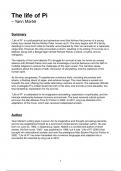The life of Pi
– Yann Martel
Summary
"Life of Pi" is a philosophical and adventure novel that follows the journey of a young
Indian boy named Piscine Molitor Patel, known as Pi. The story begins with Pi's family
deciding to move from India to Canada, accompanied by their zoo animals on a Japanese
cargo ship. However, the ship encounters a storm, resulting in its sinking. Pi survives on a
lifeboat, along with a Bengal tiger named Richard Parker, a zebra, a hyena, and an
orangutan.
The majority of the novel depicts Pi's struggle for survival at sea. He forms an uneasy
alliance with Richard Parker and uses his knowledge of animal behaviour and his faith in
multiple religions to endure the challenges of the open ocean. The narrative raises
questions about the nature of faith, the power of storytelling, and the resilience of the
human spirit.
As the story progresses, Pi experiences numerous trials, including encounters with
sharks, a oating island of algae, and extreme hunger. The novel takes a surreal turn
towards the end, o ering the reader alternative versions of events. The Japanese o cials
who investigate Pi's ordeal doubt the truth of his story and provide a more plausible, but
less fantastical, explanation for his survival.
"Life of Pi" is celebrated for its imaginative storytelling, exploration of spirituality, and the
intricate relationship between humans and animals. The book received critical acclaim
and won the Man Booker Prize for Fiction in 2002. In 2012, Ang Lee directed a lm
adaptation of the novel, which also received widespread acclaim.
Author
Yann Martel's writing style is known for its imaginative and thought-provoking elements,
and he has established himself as a prominent contemporary Canadian author. He was
born on June 25, 1963, in Salamanca, Spain. Martel is a novelist and author of short
stories. His rst novel, "Self," was published in 1996, but it was "Life of Pi" (2001) that
brought him international acclaim and won the prestigious Man Booker Prize for Fiction in
2002. "Life of Pi" has been translated into numerous languages and adapted into a
successful lm directed by Ang Lee in 2012.
1
 fl fifi ff fi ffi
, Plot
The plot of "Life of Pi" is divided into three main parts, each unfolding a di erent aspect
of the protagonist's journey.
Part 1: Pondicherry Zoo and the Shipwreck
The story begins in the town of Pondicherry, India, where a young boy named Piscine
Molitor Patel, known as Pi, grows up in his family's zoo. Pi is fascinated by animals and
also explores various religions, embracing Hinduism, Christianity, and Islam. The family
decides to move to Canada, taking some of the animals on a Japanese cargo ship named
the Tsimtsum. However, the ship encounters a severe storm in the Paci c Ocean, leading
to its sinking. Pi nds himself stranded on a lifeboat with a Bengal tiger named Richard
Parker, a zebra, a hyena, and an orangutan.
Part 2: Life on the Lifeboat
Pi's struggle for survival at sea becomes the central focus of the novel. He devises ways
to coexist with the animals on the lifeboat, establishes a hierarchical order, and uses his
knowledge of animal behaviour to navigate the challenges of the open ocean. Pi also
draws on his faith in multiple religions to nd hope and meaning in his dire circumstances.
The relationship between Pi and Richard Parker evolves as they share the limited space
on the lifeboat.
Part 3: The Paci c Island and Rescue
After spending an extended period adrift, Pi and Richard Parker reach a mysterious island
made of algae. Pi discovers that the island is carnivorous, sustaining itself by digesting
the marine life that washes ashore. Realising the danger, Pi and Richard Parker leave the
island and continue their journey. Eventually, Pi is rescued by a Japanese ship. When
o cials question him about his ordeal, Pi recounts his fantastical story involving the
animals and the carnivorous island. However, they nd it implausible and press him for a
more realistic version of events.
The novel concludes with Pi o ering a di erent narrative, one that is darker and more
brutal, involving human survivors rather than animals. The Japanese o cials choose to
accept the less fantastical version, leaving the true nature of Pi's experience open to
interpretation.
2
 ffi
fifi ff fffi fi ffifi ff




